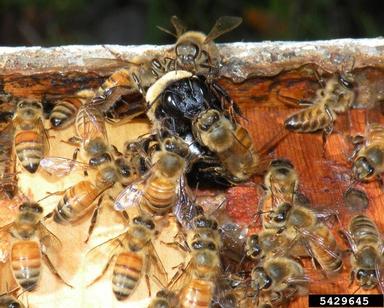Jean Williams-Woodward, UGA Plant Pathologist
Rose rosette virus is a damaging disease that is seeing an increase in occurrence across midwestern and southern states. Rose rosette has been described since the 1940s, but it wasn’t until 2011 that the causal agent was confirmed to be a virus spread by the ‘rose leaf curl’ eriophyid mite (Phyllacoptes fructiphylus).

Rose rosette virus was predominantly found in multiflora roses (Rosa multiflora) that now grow wild in many places and is considered an invasive/noxious weed. The wild multiflora roses were thought to be how the mite and virus spread into rose landscape plantings. What is causing greater concern is that the virus is now being seen in Knock-Out roses (see images). Knock-Out roses cover commercial and residential landscapes throughout the south because they are more disease resistance than other hybrid roses. The presence of the mass Knock-Out plantings provides an easy means for the mite and virus to spread from plant to plant and location to location. The increase in the amount of rose rosette showing up in Knock-Outs, which are all vegetatively propagated, has led to speculation that the virus may be spreading through nursery stock as well. This is possible, but currently I don’t have any evidence of this.
Symptoms of rose rosette virus mimic herbicide injury. In the past, we had no way of confirming the pathogen’s presence and often tried to rule out improper herbicide use. Symptoms include an increased and rapid elongation of new growth; abnormal reddish discoloration of shoots and foliage (see image above); witches broom (proliferation of new shoots); an overabundance of thorns; and deformed buds and flowers.
We are testing a molecular PCR test in the Athens clinic that can detect the virus RNA in order to confirm the disease. This test is the only way we can confirm virus infection.
If rose rosette virus is confirmed or suspected, control options are few. There is no cure for rose rosette. Roses growing near infected cultivated or wild (multiflora) roses have a high risk of infection.
To prevent infection:
- Inspect new nursery stock for symptoms of infection.
- Remove all multiflora roses from the area and increase plant spacing so rose plants will not touch each other to reduce mite spread.
- If rose rosette is present, completely remove the infected plant by bagging and discarding or by burning.
- There is some discussion on online garden forums and from rose breeders that just pruning off symptomatic canes/stems will remove the virus. There is not at present any scientific evidence that this will work. Therefore, the prudent recommendation I can give is to completely remove the infected plant.
- A miticide can help reduce mite (and virus) spread; however, miticides labeled for spider mite control and those commonly packaged for homeowners are ineffective on eriophyid mites. If homeowners want to have their roses sprayed, then they should contact commercially licensed landscape professionals who can use (per communication with entomologist Will Hudson) Avid (or other abamectin generics), Floramite, Magus, and Forbid.


